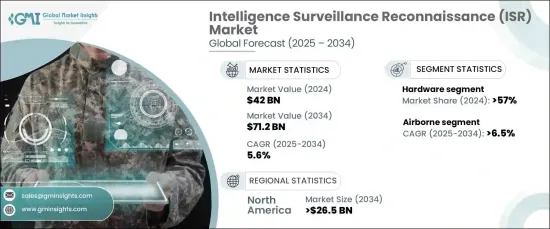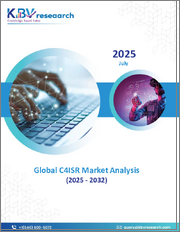
|
시장보고서
상품코드
1666527
정보 감시 정찰 시장 기회, 성장 촉진요인, 산업 동향 분석, 예측(2025-2034년)Intelligence Surveillance Reconnaissance (ISR) Market Opportunity, Growth Drivers, Industry Trend Analysis, and Forecast 2025 - 2034 |
||||||
세계의 정보 감시 정찰 시장은 2024년에 420억 달러에 달하며, 2025-2034년에 CAGR 5.6%를 보일 전망입니다.
이러한 급격한 성장은 국방, 안보, 정보 등 주요 부문 전반에서 고급 ISR 솔루션에 대한 수요가 증가하고 있기 때문입니다. 국가 안보 위협이 진화함에 따라 정부 및 국방 기관은 실시간 정보 수집, 상황 인식 강화, 다양한 환경에서의 작전적 우위를 확보하기 위해 보다 진보된 ISR 시스템을 요구하고 있습니다. 또한 인공지능(AI), 머신러닝(ML), 자율 시스템 등 첨단 기술의 발전은 이러한 수요를 더욱 촉진하고 있으며, ISR 시장은 국방 분야뿐만 아니라 국경 관리, 법 집행, 재난 관리와 같은 민간 분야에도 필수적인 요소로 자리 잡고 있습니다.

시장은 소프트웨어, 하드웨어, 서비스로 구분됩니다. 하드웨어 분야는 2024년 시장의 57%로 가장 큰 점유율을 차지할 것으로 예상되며, 향후에도 빠른 성장이 예상됩니다. 이 부문의 성장은 고해상도 카메라, 열화상 카메라, 레이더, LiDAR(Light Detection and Ranging) 시스템 등 센서 기술의 혁신에 기인합니다. 이러한 발전은 ISR 시스템의 정확도, 항속거리, 적응성을 향상시켜 육지, 공중, 해상에서 효과적으로 운용할 수 있게 해줍니다. 또한 드론 및 휴대용 지상 시스템과 같은 소형 경량 ISR 장비에 대한 수요가 증가함에 따라 제조업체들은 높은 운영 효율성을 유지하는 소형 모듈형 설계에 집중하고 있습니다.
| 시장 범위 | |
|---|---|
| 시작연도 | 2024년 |
| 예측연도 | 2025-2034년 |
| 시작 금액 | 420억 달러 |
| 예상 금액 | 712억 달러 |
| CAGR | 5.6% |
플랫폼별로 살펴보면, ISR 시장은 육상, 해상, 공중, 우주 기반 플랫폼으로 구분됩니다. 그 중에서도 공중 ISR 시스템은 2034년까지 6.5%의 연평균 복합 성장률(CAGR)로 높은 성장이 예상됩니다. 정보 수집 및 감시를 위한 무인항공기 시스템(UAS)과 드론의 광범위한 채택이 이러한 성장의 주요 원동력입니다. 이러한 플랫폼은 실시간 데이터 수집을 위한 비용 효율적인 솔루션을 제공하며, 특히 까다롭고 위험한 환경에서 운영할 수 있다는 점에서 높은 평가를 받고 있습니다. 최신 공중 ISR 시스템은 고해상도 이미징, 합성개구레이더(SAR), 전자전 능력을 결합한 첨단 센서 페이로드를 갖추고 있으며, 군 및 방어 작전의 효율성을 크게 향상시키고 있습니다.
북미는 ISR 시장에서 지배적인 위치를 유지할 것으로 예상되며, 2034년 시장 규모는 265억 달러에 달할 것으로 추정됩니다. 특히 미국은 국방 현대화에 대한 막대한 투자를 통해 이러한 성장을 주도하고 있습니다. 미국 국방부는 다중 도메인 작전에 중점을 두고 AI, ML, 자율 기술을 ISR 시스템에 통합하고 있으며, ISR 임무에서 무인 항공기 시스템에 대한 의존도가 높아짐에 따라 북미에서 이 시장의 모멘텀을 유지하고 ISR 기술에서 북미의 리더십을 공고히할 것으로 예상됩니다. 북미의 ISR 기술 리더십을 확고히할 것으로 예상됩니다.
목차
제1장 조사 방법과 조사 범위
- 시장 범위와 정의
- 기본 추정과 계산
- 예측 계산
- 데이터 소스
- 1차 데이터
- 2차 데이터
- 유료 정보원
- 공적 정보원
제2장 개요
제3장 업계 인사이트
- 에코시스템 분석
- 밸류체인에 영향을 미치는 요인
- 이익률 분석
- 파괴
- 향후 전망
- 제조업체
- 유통업체
- 공급업체 상황
- 이익률 분석
- 주요 뉴스
- 규제 상황
- 영향요인
- 촉진요인
- 고해상도 우주 기반 ISR 위성의 개발 대수 증가
- 국경 경비, 군 정찰, 재해 감시를 포함한 ISR 태스크에 대한 드론의 사용 증가
- 첨단 데이터 처리 시스템의 채택 확대
- 특히 분쟁이 일어나기 쉬운 지역에서 안보상 우려의 증가
- 지속적 감시를 위한 우주 기반 ISR 플랫폼의 강화에 중점을 두는 정부의 증가
- 업계의 잠재적 리스크 & 과제
- 높은 운영 비용과 개발비
- 사이버 보안과 데이터 프라이버시에 관한 리스크
- 촉진요인
- 성장 가능성 분석
- Porter의 산업 분석
- PESTEL 분석
제4장 경쟁 구도
- 서론
- 기업 점유율 분석
- 경쟁 포지셔닝 매트릭스
- 전략 전망 매트릭스
제5장 시장 추산·예측 : 솔루션별, 2021-2034년
- 주요 동향
- 하드웨어
- 감시 시스템
- 통신 시스템
- 시그널 인텔리전스(SIGINT) 시스템
- 기타
- 소프트웨어
- 서비스
제6장 시장 추산·예측 : 용도별, 2021-2034년
- 주요 동향
- 군 오퍼레이션
- 안보
- 테러 대책
- 감시
- 기타
제7장 시장 추산·예측 : 플랫폼별, 2021-2034년
- 주요 동향
- 육상
- 해군
- 낙하산
- 우주
제8장 시장 추산·예측 : 최종 용도별, 2021-2034년
- 주요 동향
- 방위·군
- 정부기관
- 상업
제9장 시장 추산·예측 : 지역별, 2021-2034년
- 주요 동향
- 북미
- 미국
- 캐나다
- 유럽
- 영국
- 독일
- 프랑스
- 이탈리아
- 스페인
- 러시아
- 아시아태평양
- 중국
- 인도
- 일본
- 한국
- 호주
- 라틴아메리카
- 브라질
- 멕시코
- 중동 및 아프리카
- 남아프리카공화국
- 사우디아라비아
- 아랍에미리트
제10장 기업 개요
- BAE Systems
- Boeing
- Elbit Systems
- General Atomics
- General Dynamics
- Israel Aerospace Industries
- Kratos Defense
- L3Harris
- Lockheed Martin
- Northrop Grumman
- Raytheon Technologies
- Rheinmetall
- Saab
- Textron
- Thales
The Global Intelligence Surveillance Reconnaissance Market reached USD 42 billion in 2024 and is poised to exhibit a CAGR of 5.6% from 2025 to 2034. This rapid growth is largely driven by the increasing demand for advanced ISR solutions across critical sectors, including defense, security, and intelligence. As national security threats evolve, governments and defense organizations are seeking more sophisticated ISR systems to gather real-time intelligence, enhance situational awareness, and ensure operational superiority in a variety of environments. In addition, the rise of advanced technologies such as artificial intelligence (AI), machine learning (ML), and autonomous systems has further fueled this demand. The ISR market is becoming integral not only to defense applications but also to civil sectors like border control, law enforcement, and disaster management.

The market is segmented into software, hardware, and services. The hardware segment held the largest share in 2024, capturing 57% of the market, and is expected to continue expanding rapidly. This segment's growth is attributed to the innovations in sensor technologies, including high-resolution cameras, thermal imagery, radar, and Light Detection and Ranging (LiDAR) systems. These advancements enhance the accuracy, range, and adaptability of ISR systems, enabling them to operate effectively across land, air, and sea domains. Additionally, the increasing demand for compact, lightweight ISR equipment such as drones and portable ground systems is prompting manufacturers to focus on smaller, modular designs that maintain high operational efficiency.
| Market Scope | |
|---|---|
| Start Year | 2024 |
| Forecast Year | 2025-2034 |
| Start Value | $42 Billion |
| Forecast Value | $71.2 Billion |
| CAGR | 5.6% |
In terms of platforms, the ISR market is divided into land, naval, airborne, and space-based platforms. Among these, airborne ISR systems are expected to see the highest growth, with a strong CAGR of 6.5% through 2034. The widespread adoption of unmanned aerial systems (UAS) and drones for intelligence gathering and surveillance is a key driver of this growth. These platforms provide a cost-effective solution for real-time data collection and are particularly valued for their ability to operate in challenging and hazardous environments. Modern airborne ISR systems are equipped with advanced sensor payloads that combine high-resolution imaging, Synthetic Aperture Radar (SAR), and electronic warfare capabilities, significantly boosting their effectiveness in military and defense operations.
North America is expected to maintain its dominant position in the ISR market, with an estimated market value of USD 26.5 billion by 2034. The United States, in particular, is driving this growth through substantial investments in defense modernization. The U.S. Department of Defense is focusing heavily on multi-domain operations, integrating AI, ML, and autonomous technologies into ISR systems. The increasing reliance on unmanned aerial systems for ISR missions is expected to sustain this market momentum in the region, cementing North America's leadership in ISR technology.
Table of Contents
Chapter 1 Methodology & Scope
- 1.1 Market scope & definitions
- 1.2 Base estimates & calculations
- 1.3 Forecast calculations
- 1.4 Data sources
- 1.4.1 Primary
- 1.4.2 Secondary
- 1.4.2.1 Paid sources
- 1.4.2.2 Public sources
Chapter 2 Executive Summary
- 2.1 Industry synopsis, 2021-2034
Chapter 3 Industry Insights
- 3.1 Industry ecosystem analysis
- 3.1.1 Factor affecting the value chain
- 3.1.2 Profit margin analysis
- 3.1.3 Disruptions
- 3.1.4 Future outlook
- 3.1.5 Manufacturers
- 3.1.6 Distributors
- 3.2 Supplier landscape
- 3.3 Profit margin analysis
- 3.4 Key news & initiatives
- 3.5 Regulatory landscape
- 3.6 Impact forces
- 3.6.1 Growth drivers
- 3.6.1.1 Rising development of high-resolution, space-based ISR satellites
- 3.6.1.2 Increasing use of drones for ISR tasks, including border patrol, military reconnaissance, and disaster monitoring
- 3.6.1.3 Growing adoption of advanced data processing systems
- 3.6.1.4 Rising security concerns, especially in conflict-prone regions
- 3.6.1.5 Growing government focuses on enhancing space-based ISR platforms for continuous surveillance
- 3.6.2 Industry pitfalls & challenges
- 3.6.2.1 High operational and development costs
- 3.6.2.2 Cybersecurity and data privacy risks
- 3.6.1 Growth drivers
- 3.7 Growth potential analysis
- 3.8 Porter’s analysis
- 3.9 PESTEL analysis
Chapter 4 Competitive Landscape, 2024
- 4.1 Introduction
- 4.2 Company market share analysis
- 4.3 Competitive positioning matrix
- 4.4 Strategic outlook matrix
Chapter 5 Market Estimates & Forecast, By Solution, 2021-2034 (USD Million)
- 5.1 Key trends
- 5.2 Hardware
- 5.2.1 Surveillance systems
- 5.2.2 Communication systems
- 5.2.3 Signal Intelligence (SIGINT) systems
- 5.2.4 Others
- 5.3 Software
- 5.4 Services
Chapter 6 Market Estimates & Forecast, By Application, 2021-2034 (USD Million)
- 6.1 Key trends
- 6.2 Military operations
- 6.3 Security
- 6.4 Counter terrorism
- 6.5 Surveillance
- 6.6 Others
Chapter 7 Market Estimates & Forecast, By Platform, 2021-2034 (USD Million)
- 7.1 Key trends
- 7.2 Land
- 7.3 Naval
- 7.4 Airborne
- 7.5 Space
Chapter 8 Market Estimates & Forecast, By End Use, 2021-2034 (USD Million)
- 8.1 Key trends
- 8.2 Defense & military
- 8.3 Government
- 8.4 Commercial
Chapter 9 Market Estimates & Forecast, By Region, 2021-2034 (USD Million)
- 9.1 Key trends
- 9.2 North America
- 9.2.1 U.S.
- 9.2.2 Canada
- 9.3 Europe
- 9.3.1 UK
- 9.3.2 Germany
- 9.3.3 France
- 9.3.4 Italy
- 9.3.5 Spain
- 9.3.6 Russia
- 9.4 Asia Pacific
- 9.4.1 China
- 9.4.2 India
- 9.4.3 Japan
- 9.4.4 South Korea
- 9.4.5 Australia
- 9.5 Latin America
- 9.5.1 Brazil
- 9.5.2 Mexico
- 9.6 MEA
- 9.6.1 South Africa
- 9.6.2 Saudi Arabia
- 9.6.3 UAE
Chapter 10 Company Profiles
- 10.1 BAE Systems
- 10.2 Boeing
- 10.3 Elbit Systems
- 10.4 General Atomics
- 10.5 General Dynamics
- 10.6 Israel Aerospace Industries
- 10.7 Kratos Defense
- 10.8 L3Harris
- 10.9 Lockheed Martin
- 10.10 Northrop Grumman
- 10.11 Raytheon Technologies
- 10.12 Rheinmetall
- 10.13 Saab
- 10.14 Textron
- 10.15 Thales



















